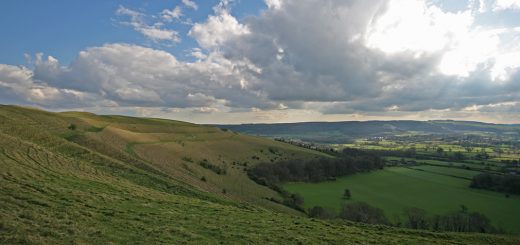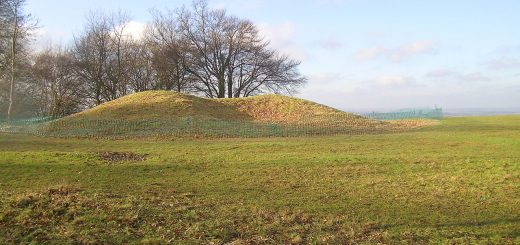Fonaby Stone
An ancient stone referred to as the Sack Stone could be found at Fonaby. An old picture of the stone shows it had the look of a sack about it, which probably led to the folk story that developed around it.
According to ‘The Folklore Of Lincolnshire by Mabel Peacock (December 1900).’ A certain man was sowing beans on Fonaby Top, not far from Caistor, on a stormy day, when the wind became so strong that it blew the beans out of the field. “Damn the wind!” ejaculated the sower. Whereon he and the sack from which he was taking his seed were instantaneously turned into stone. To confirm the truth of the story, the boulder into which the man was changed may, or might till lately, be seen at a little distance from the transformed sack. It is remarkable that a legend of a different type, referring apparently to this same sack, was related to Mr. C. F- not many months ago. “Last week I was talking to an old man, who told me that Jesus Christ once came to Caistor, and went into a field there, and asked the farmer in it for some bread. The farmer gave him the only loaf he had. Thereupon Christ turned the stones lying near into sacks of barley, one of which lies in the (field now, a huge stone like a sack tied up at one end.”
There is also a third story which seems to be connected with the same stone. This tale was picked up not long since as far away from home as the Argentine Republic, One of my brothers met a member of a well-known family of Lincolnshire wold farmers at Buenos Ayres, who told him the substance of what follows here. On the road from Caistor to Grimsby, in a field by the highway, there stands or used to stand a stone known as the “Traveller’s Corn Sack.” One winter’s day, many years ago, a horseman rode along the road—at that time little more than a track across the open wolds—making his way towards Grimsby. As he pressed forward he saw a man busy at work sowing grain, and drew near to ask him if he would give or sell him some of it for his horse, which like its master showed signs of a long journey. “I am short of corn myself,” was the sower’s reply, “I can neither give nor sell.” But the wayfarer’s glance had fallen on a sack which was standing near. “You have a sack there still full,” he urged, “and you have almost done sowing. Give me something for my horse.” “That!” cried the sower; that is a great cobble-stone, and no sack of corn! “Receiving this churlish and untruthful refusal the rider’s wrath was roused, and in his anger he uttered the following words: “Saints reward both thee and thine, As thou rewardest me and mine. A stone, thou sayest, I can see— Stone for ever shall it be I” – And having spoken thus he passed on his way, leaving the startled husbandman to find that the sack had, indeed, become stone. According to the story, there it stood with its very seams and stitching, its pursed-up mouth, and the cord that bound it, even to the twist of the strands all showing, as they had shown before the spell was spoken. And there it remained through wind and weather, a thing of wonder and awe. But at last strangers came to live on the land, who put no faith in old-time tales. After a while it was found that the stone was in the way, therefore the holder of the farm on which it lay decided to have it moved, although the greybeards of the township warned him to let well alone. The task which he had set himself proved to be not only difficult, but unlucky also. All the horses and draught-oxen belonging to the man could scarcely drag the block to his homestead, so heavy did they find it. And in a short time his live stock began to sicken, some of the animals dying. Still the farmer was deaf to the voice of the “old standards.” Not till his son, an only child, lay at death’s door, could he be convinced of his folly. Then his ‘stubbornness had to yield. The stone was placed on his best wagon, and the teams brought out to be yoked to it. But scarcely was the old grey mare between the shafts when she started off alone drawing the once burdensome load with ease, although the road back to the field was up-hill. This wonder became widely known, and the old awe of the “Corn Sack ” took a new lease of life.




Recent Comments